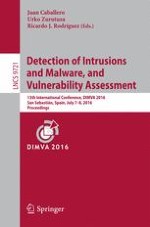2016 | OriginalPaper | Buchkapitel
AutoRand: Automatic Keyword Randomization to Prevent Injection Attacks
verfasst von : Jeff Perkins, Jordan Eikenberry, Alessandro Coglio, Daniel Willenson, Stelios Sidiroglou-Douskos, Martin Rinard
Erschienen in: Detection of Intrusions and Malware, and Vulnerability Assessment
Aktivieren Sie unsere intelligente Suche, um passende Fachinhalte oder Patente zu finden.
Wählen Sie Textabschnitte aus um mit Künstlicher Intelligenz passenden Patente zu finden. powered by
Markieren Sie Textabschnitte, um KI-gestützt weitere passende Inhalte zu finden. powered by
